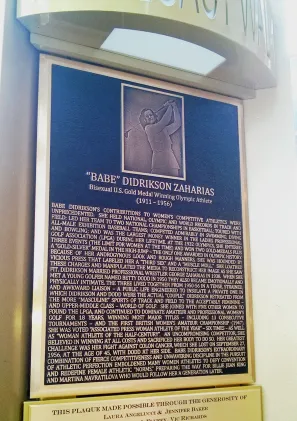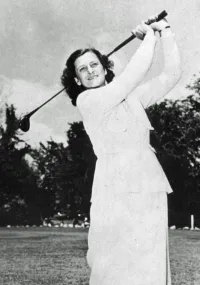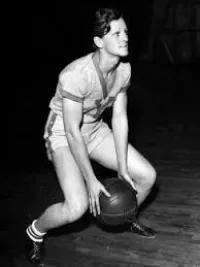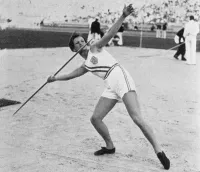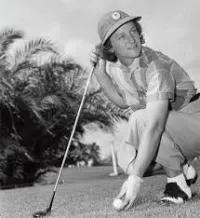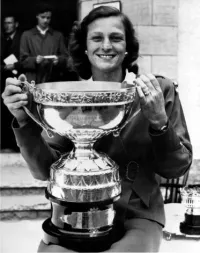Plaque Sponsor
Laura Angelucci and Jennifer Baker; Pslam One and Fluffy; Vic Richards, Chris Pritchard, Michael Shields and The Highfield GroupBiography
1911 - 1956
"The formula for success is simple: practice and concentration then more practice and more concentration."
- Babe Didrickson
Babe Didrikson’s contributions to women’s competitive athletics were unprecedented. She held national, Olympic and World records in track and field; led her team to two national championships in basketball; toured with all-male exhibition baseball teams; competed admirably in swimming, diving and bowling; and was the largest money winner in the Ladies Professional Golf Association (LPGA) during her lifetime. At the 1932 Olympics, she entered three events (the limit for women at the time) and won two gold-medals plus a “gold-silver” medal in the high-jump – the only one awarded in Olympic history. Because of her androgynous look and rough manners, she was hounded by vicious press that labeled her a “Third Sex,” and a “muscle moll.” She loathed these charges and manipulated the media to reconstruct her image as she saw fit. Didrikson married professional wrestler George Zaharias in 1938. When she met a young golfer named Betty Dodd in 1950 they also became emotionally and physically intimate. The three lived together from 1950-56 in a tense, strained, and awkward liaison – a public life engineered to insulate a private one in which Didrikson and Dodd were the actual “couple.” Didrikson retreated from the more “masculine” sports of track and field to the acceptably feminine – and upper-middle class – world of golf. She joined with five other women to found the LPGA, and continued to dominate amateur and professional women’s golf for 18 years, winning most major titles – including 13 consecutive tournaments – and the first British Women’s Amateur Championship (1947). She was voted “Associated Press Woman Athlete of the Year” – six times – as well as “Woman Athlete of the Half-Century”. An uncompromising competitor, she believed in winning at all costs and sacrificed her body to do so. Her greatest challenge was her fight against colon cancer, which she lost on September 27, 1956, at the age of 45, with Dodd at her side. Babe Didrikson’s extraordinary combination of fierce competitiveness and unwavering discipline in the pursuit of athletic perfection emboldened many women athletes to defy convention and redefine female athletic “norms,” preparing the way for Billie Jean King and Martina Navratilova who would follow her a generation later.
1911 - 1956
"The formula for success is simple: practice and concentration then more practice and more concentration."
- Babe Didrickson
Babe Didrikson’s contributions to women’s competitive athletics were unprecedented. She held national, Olympic and World records in track and field; led her team to two national championships in basketball; toured with all-male exhibition baseball teams; competed admirably in swimming, diving and bowling; and was the largest money winner in the Ladies Professional Golf Association (LPGA) during her lifetime. At the 1932 Olympics, she entered three events (the limit for women at the time) and won two gold-medals plus a “gold-silver” medal in the high-jump – the only one awarded in Olympic history. Because of her androgynous look and rough manners, she was hounded by vicious press that labeled her a “Third Sex,” and a “muscle moll.” She loathed these charges and manipulated the media to reconstruct her image as she saw fit. Didrikson married professional wrestler George Zaharias in 1938. When she met a young golfer named Betty Dodd in 1950 they also became emotionally and physically intimate. The three lived together from 1950-56 in a tense, strained, and awkward liaison – a public life engineered to insulate a private one in which Didrikson and Dodd were the actual “couple.” Didrikson retreated from the more “masculine” sports of track and field to the acceptably feminine – and upper-middle class – world of golf. She joined with five other women to found the LPGA, and continued to dominate amateur and professional women’s golf for 18 years, winning most major titles – including 13 consecutive tournaments – and the first British Women’s Amateur Championship (1947). She was voted “Associated Press Woman Athlete of the Year” – six times – as well as “Woman Athlete of the Half-Century”. An uncompromising competitor, she believed in winning at all costs and sacrificed her body to do so. Her greatest challenge was her fight against colon cancer, which she lost on September 27, 1956, at the age of 45, with Dodd at her side. Babe Didrikson’s extraordinary combination of fierce competitiveness and unwavering discipline in the pursuit of athletic perfection emboldened many women athletes to defy convention and redefine female athletic “norms,” preparing the way for Billie Jean King and Martina Navratilova who would follow her a generation later.
Lesson Plan
Please login or register for an account to view this lesson plan.
Demography
Demography
Gender Female
Sexual Orientation Bisexual
Gender Identity Cisgender
Ethnicity Caucasian/White
Nations Affiliated United States
Era/Epoch Interwar Period (1918-1939)
Field(s) of Contribution
Athletics
Music
Social Justice
Social Sciences
Sports & Fitness
US History
Commemorations & Honors
10th Greatest North American Athlete of the 20th Century by ESPN
9th Greatest Athlete of the 20th Century by the Associated Press
Multiple Years LPGA Tournament Winner
Two Time Olympic Gold Medalist for Track and Field (1932)
LPGA Co-Founder (1949)
World Golf Hall of Fame Inductee (1951)
Babe Zaharias Open Named After Her (1953-1967)
LPGA Vare Trophy (1954)
Posthumous Bob Jones Award by the United States Golf Association (1957)
Posthumous National Track and Field Hall of Fame Inductee (1974)
Posthumous National Women's Hall of Fame Inductee (1976)
Posthumous LPGA Hall of Fame Inductee at its Inception (1977)
Commemorative U.S. Postage Stamp (1981)
Posthumous U.S. Olympic Hall of Fame Inductee (1983)
Demography
Gender Female
Sexual Orientation Bisexual
Gender Identity Cisgender
Ethnicity Caucasian/White
Nations Affiliated United States
Era/Epoch Interwar Period (1918-1939)
Field(s) of Contribution
Athletics
Music
Social Justice
Social Sciences
Sports & Fitness
US History
Commemorations & Honors
10th Greatest North American Athlete of the 20th Century by ESPN
9th Greatest Athlete of the 20th Century by the Associated Press
Multiple Years LPGA Tournament Winner
Two Time Olympic Gold Medalist for Track and Field (1932)
LPGA Co-Founder (1949)
World Golf Hall of Fame Inductee (1951)
Babe Zaharias Open Named After Her (1953-1967)
LPGA Vare Trophy (1954)
Posthumous Bob Jones Award by the United States Golf Association (1957)
Posthumous National Track and Field Hall of Fame Inductee (1974)
Posthumous National Women's Hall of Fame Inductee (1976)
Posthumous LPGA Hall of Fame Inductee at its Inception (1977)
Commemorative U.S. Postage Stamp (1981)
Posthumous U.S. Olympic Hall of Fame Inductee (1983)
Resources
Resources
Cayleff, Susan E. Babe: The Life and Legend of Babe Didrikson Zaharias. Urbana: University of Illinois Press, 1995.
Knudson, R. Rozanne. Babe Didrikson: Athlete of the Century. New York: Viking Kestrel, 1985.
Lynn, Elizabeth A. Babe Didrikson Zaharias. New York: Chelsea House, 1989.
Postman, Andrew. "Athlete Of The Century: Babe Didrikson." Women's Sports and Fitness 3.2 (January 2000): 110.
Zaharias, Babe Didrikson, with Harry Paxton. This Life I've Led: My Autobiography. NewYork: Barnes, 1955.
https://www.lesbiannews.com/babe-didrikson-breaking-sports-barrier/
Resources
Cayleff, Susan E. Babe: The Life and Legend of Babe Didrikson Zaharias. Urbana: University of Illinois Press, 1995.
Knudson, R. Rozanne. Babe Didrikson: Athlete of the Century. New York: Viking Kestrel, 1985.
Lynn, Elizabeth A. Babe Didrikson Zaharias. New York: Chelsea House, 1989.
Postman, Andrew. "Athlete Of The Century: Babe Didrikson." Women's Sports and Fitness 3.2 (January 2000): 110.
Zaharias, Babe Didrikson, with Harry Paxton. This Life I've Led: My Autobiography. NewYork: Barnes, 1955.
https://www.lesbiannews.com/babe-didrikson-breaking-sports-barrier/
